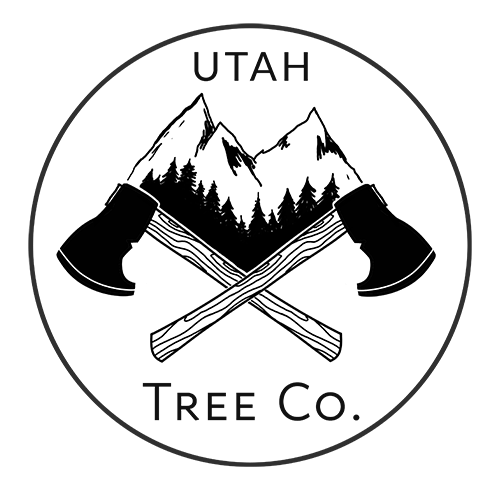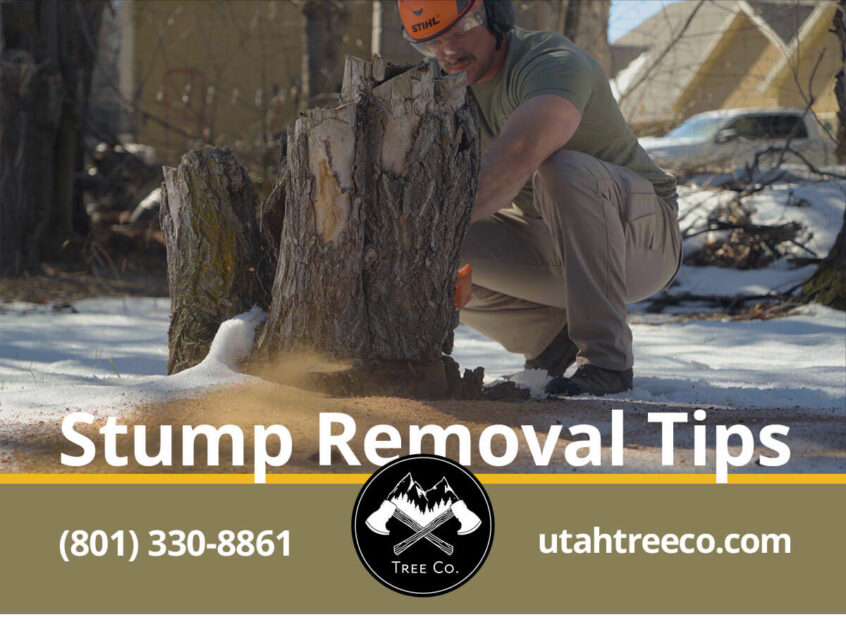In Utah, summers are usually hot and dry. So, planting trees on your Utah property comes with many benefits. They provide shade, lower the temperature, reduce air-conditioning costs, protect your house from storms and strong winds, add beauty to your outdoors, and increase property value.
Sometimes, however, removing or cutting down a tree makes sense. For example, a diseased or decaying tree or a tree that becomes a potential safety hazard for your house needs to be cut down. When you cut down a tree, however, you are left with a tree stump.
Tree stump removal is perhaps the most tedious but critical step involved in cutting down a tree. Before discussing different tree stump removal methods, let’s understand what a tree stump is and why you need to remove it.
What Is a Tree Stump?
The tree stump is usually a small part of the tree trunk left after cutting down a tree. The roots of the tree stump are still intact. As a result, sometimes stumps can sprout into new trees (deciduous trees). The process takes years, and it is often not desirable when it comes to outdoor landscaping.
Why Is Tree Stump Removal Necessary?
As you can imagine, leaving a tree stump in your backyard, garden or lawn is not desirable for several reasons. Here are a few of them.
- Tree stumps are an eyesore and reduce the aesthetic appeal of your property considerably. Nobody wants to buy a house with a lawn having a decaying tree stump.
- Tree stumps will start decaying over time, making them a house of infestations like pests, organisms, fungi, and even diseases. This pest can quickly spread to other areas of your garden.
- Tree stumps are also a safety hazard, especially if you have children playing in the backyard or on your lawn. They can trip over the stump, resulting in cuts and bruises.
- Sometimes, invasive plants can start growing around a tree stump. These plants can soon take over your garden.
- As the roots are intact, the tree stump may start sprouting again. However, it’ll compete with other plants for nutrition and water, hindering their growth.
Understanding the Most Common Tree Stump Removal Methods
Now that you have understood why removing a tree stump is necessary, let’s check out a few ways to do it safely and efficiently. Here are five common tree stump removal methods you can use.
1. Remove Stump Manually
The old-fashioned manual work is one of the best, and probably the fastest ways, to remove a tree stump. This method, however, is more suitable for small to medium-sized tree stumps. For large ones, you may need to use another tree stump removal method or call professionals.
To remove a tree stump manually, you will need tools like a digging bar, bow saw, ax, and mattock. Although faster, this is also a labor-intensive stump removal process. So, be prepared to put your back into it.
- The first step is to dig around the stump to expose the large roots as much as possible using the mattock.
- You can use the shovel to loosen and remove excess dirt and expose the roots.
- Once you have unearthed the roots as much as you can, use the ax or a bow saw to cut the roots.
- However, make sure the roots are exposed completely. If tree stump roots are unexposed, you may end up hitting a rock when cutting them. It can shatter your ax. Or worse, you may get injured.
- Pull out the chopped roots and keep going until you reach the taproot.
- Dig and clear the area around the taproot. Cut the taproot and dislodge the stump using the shovel.
- After the tree stump removal is complete, use loam or sawdust to fill in the hole.
The process usually takes a few hours (10hrs – 12hrs). However, it may take longer depending on your DIY skills. But the stump will be gone as soon as you finish filling up the hole.
2. Remove Stump by Burning
Burning is also one of the old-school methods of tree stump removal. However, you may need to make sure it is legal to burn a stump in your area. Talk to the fire department or local authorities before using this method.
You will need a powdered tree stump remover, kerosene, ax, shovel, and power drill. The powdered tree stump remover will make the stump porous, allowing it to soak the kerosene efficiently.
- Drill the holes in the tree stump, and add the powdered tree stump remover.
- After a while, you can add kerosene to the stump holes. Let the stump absorb the kerosene.
- Now, you can burn the tree stump. Keep monitoring it to make sure the entire stump burns.
- Shovel the ash out and dispose of it properly.
- Fill in the hole with loam or sawdust.
3. Remove Stump Using Chemicals
If manual labor is not your thing, you can use chemicals to remove the tree stump. You will need a chainsaw, drill, plastic tarp, garden mulch, ax, and potassium nitrate for chemical tree stump removal.
Potassium nitrate speeds up the rotting process. Still, it will take at least four weeks for the tree stump to rot and die. So, you will need to be patient.
- First, you will need to remove as much of the tree stump as you can using the chainsaw.
- Next, drill evenly spaced holes into the tree stump. These holes need to be close to each other and as deep and broad as possible. It’ll allow the stump to absorb potassium nitrate quickly.
- Add water to the holes first, then add the potassium nitrate. If you are using a chemical stump remover, check the package for instructions.
- Soak the ground around the circumference of the tree stump using water.
- Once the ground is moist, cover the area with a plastic tarp.
- Now, cover the tarp with mulch and moisten it with water.
- You have to keep this assembly moist. Keep adding potassium nitrate, mulch, and water when required until the tree stump rots completely.
- Make sure to keep children and animals away from the tree stump during the process.
- In a few weeks (four to six), the tree stump will soften. You can remove it using an ax. Keep going until you have removed the stump.
- If the stump is hard, repeat the process until it is soft.
Make sure to use proper safety gear when working. Fill in the hole after the tree stump removal.
4. Remove Stump Using a Stump Grinder
Grinding is the fastest and the least labor-intensive tree stump removal process. However, you will need to shell out a couple of hundred dollars to rent a stump grinder. You can rent it from a local hardware store or an arborist. You will also need tools such as a shovel, mattock, rake, and chainsaw.
- Use the shovel and mattock to clear away the dirt, debris, and rocks around the tree stump.
- Also, chop down as much of the stump as you can using the chainsaw.
- Now, you can position the stump grinder over the tree stump and start grinding. You will need to move the stump grinder from side to side for efficient stump removal.
- Use loam or sawdust to fill the hole once grinding is finished.
Make sure you know how to operate a stump grinder. If you don’t, you can hire a professional arborist, which brings us to the next point.
5. Hire Professional Arborists to Remove the Stump
If you are not a DIYer or don’t want to get your hands dirty, calling in pros is your best option. It’s also the right way to remove multiple stumps quickly. Being professionals, they can remove the stumps quickly, safely, and efficiently.
You can talk to at least a couple of arborists and ask them to provide you with stump removal estimates. Make sure to find a local tree stump removal service company because they know local laws and weather better.
In addition to this, make sure the pros have the following.
- Required certifications, licenses, and permits for tree stump removal and other tree services.
- Workers’ compensation and liability insurance.
- Excellent references and substantial work experience.
- Professional and courteous behavior.
- Customer-friendly service.
- Reasonable pricing.
Parting Words
If you have a tree stump in your yard, you need to remove it as quickly as possible. It’s not only an eyesore but also a safety hazard, especially if you have kids. You can try one of these four DIY methods if you feel up to it. However, calling in pros is always a better and safer option. If you need help with tree stump removal, feel free to reach out to our team at (801) 386-2405 or through our online form. Our experts will provide you with the right stump removal solution.

